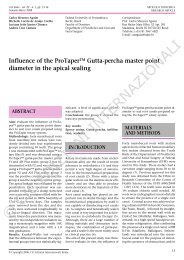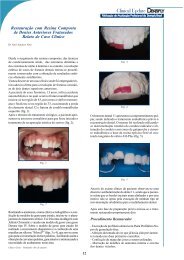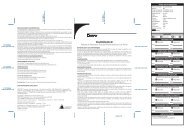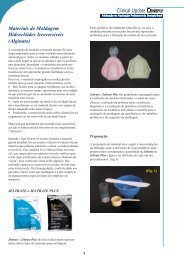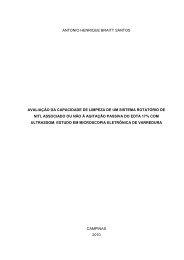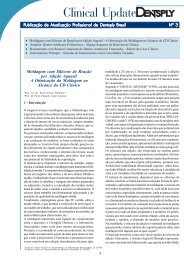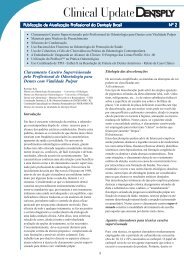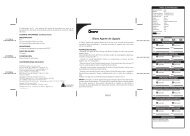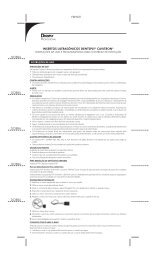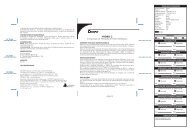You also want an ePaper? Increase the reach of your titles
YUMPU automatically turns print PDFs into web optimized ePapers that Google loves.
Rosales-Leal<br />
fect the occlusal sealing and showed that the enamel junction<br />
is resistant to aging, due to the mineral nature of the tissue<br />
which ensures a better and more durable bond. 4 In contrast,<br />
the dentin bond was susceptible to damage and the<br />
sealing was reduced after thermocycling. 18 The larger proportion<br />
of organic compounds and water in the dentin<br />
makes the union weaker for all the adhesives tested, which<br />
would explain aging. 11,17 Thermocycling accelerates the aging<br />
by hydrolytic degradation of the hydrophilic components<br />
in the bonding system. 12,22 In addition, repetitive contraction/expansion<br />
stress at the bonding interface may lead to<br />
cracks that propagate along the interface and cause in- and<br />
outflow of fluids. 5 When considering distribution of microleakage<br />
grades in all obtained slices, only XPB was not<br />
affected by thermocycling.<br />
Clinically, when a cavity is surrounded by enamel, the<br />
phosphoric acid will ensure a hermetic and durable bond.<br />
When the cavity margins are in dentin, improvements are<br />
necessary, but there are some self-etching adhesives (XNO,<br />
CLF) or etch-and-rinse adhesives (XPB) that obtain excellent<br />
results with no positive dentin permeability and low leakage.<br />
Perhaps more acidic primers could improve the sealing of<br />
composite resin restorations.<br />
CONLUSIONS<br />
In enamel, no microleakage was found when phosphoric<br />
acid was used, but self-etching adhesives showed slight<br />
leakage. The gingival sealing was inferior to the occlusal<br />
sealing. XNO and CLF obtained the best gingival sealing, followed<br />
by XPB, SBX, P&B, and IBO, with SYN demonstrating<br />
the worst sealing. Self-etching adhesives and XPB were able<br />
to hermetically seal the dentin tubules (negative permeability).<br />
Thermocycling did not affect the occlusal bonding or XPB<br />
gingival sealing.<br />
ACKNOWLEDGMENTS<br />
This research was sponsored by <strong>Dentsply</strong> DeTrey, Konstanz, Germany.<br />
3. De Munck J, Vargas M, Iracki J, Van Landuyt K, Poitevin A, Lambrechts P,<br />
Van Meerbeek B. One day bonding effectiveness of new self-etch adhesives<br />
to bur-cut enamel and dentin. Oper Dent 2005;30:39-49.<br />
4. Frankenberger R, Krämer N, Petschelt A. Long-term effect of dentin<br />
primers on enamel bond strength and marginal adaptation. Oper Dent<br />
2000;25:11-19.<br />
5. Gale MS, Darvell BW. Thermal cycling procedures for laboratory testing of<br />
dental restorations. J Dent 1999;27:89-99.<br />
6. Gueders AM, Charpentier JF, Alber AI, Geerts SO. Microleakage after thermocycling<br />
of 4 etch and rinse and 3 self-etching adhesives with and without<br />
flowable composite lining. Oper Dent 2006;31:450-455.<br />
7. Hilton TJ. Can modern procedures and materials reliably seal cavities. In<br />
vitro investigations. Part I. Am J Dent 2002;15:198-210.<br />
8. Kleverlaan CJ, Feilzer AJ. Polymerization shrinkage and contraction stress<br />
of dental composites. Dent Mater 2005;21:1150-1157.<br />
9. Koliniotou-Koumpia E, Dionysiopoulos P, Koumpia E. In vivo evaluation of<br />
microleakage from composites with new dentin adhesives. J Oral Rehabil<br />
2004;31:1014-1022.<br />
10. Manhart J, Chen HY, Mehl A, Weber K, Hickel R. Marginal quality and microleakage<br />
of adhesive class V restorations. J Dent 2001;29:123-130.<br />
11. Mjör IA, Shen C, Eliasson ST, Richter S. Placement and replacement of<br />
restorations in general dental practice in Iceland. Oper Dent 2002;<br />
27:117–123.<br />
12. Murray PE, Hafez AA, Smith AJ, Cox CF. Bacterial microleakage and pulp inflammation<br />
associated with various restorative materials. Dent Mater<br />
2002;18:470-8.<br />
13. Nakabayashi N, Pashley DH. Hybridization of dental hard tissues. Tokio:<br />
Quintessence 1998.<br />
14. Oliveira SSA, Marshall SJ, Hilton JF, Marshall GW. Etching kinetics of a selfetching<br />
primer. Biomaterials 2002;23:4105-4112.<br />
15. Owens BM, Johnson WW. Effecto of insertion technique and adhesive system<br />
on microleakage of Class V resin composite restorations. J Adhes Dent<br />
2005;7:303-308.<br />
16. Rosales-Leal JI, de la Torre-Moreno FJ, Bravo M. Effect of pulp pressure on<br />
the micropermeability and sealing ability of etch&rinse and self-etching adhesives.<br />
Oper Dent 2006; in press.<br />
17. Salz U, Zimmermman J, Zeuner F, Moszner N. Hydrolitic stability of selfetching<br />
adhesive systems. J Adhes Dent 2005;7:107-116.<br />
18. Schuckar M, Geurtsen W. Proximo-cervical adaptation of class II-compoite<br />
restorations after thermocycling: a quantitative and qualitative study. J<br />
Oral Rehabil 1997;24:766-775.<br />
19. Tay FH, Pashley DH. Aggressiveness of contemporary self-etching systems:<br />
I: Depth of penetration beyond dentin smear layers. Dent Mater 2001;<br />
17:296-308.<br />
20. Van Meerbeek B, InokoshiS, Braem M, Lambrechts P, Vanherle G. Morphological<br />
aspects of the resin-dentin interdiffusion zone with different dentin<br />
adhesive systems. J Dent Res 1992;71:1530-1540.<br />
21. Van Meerbeek B, Perdigão J, Lambrechts P, Vanherle G. The clinical performance<br />
of adhesives. J Dent 1998;26:1-20.<br />
22. Yang B, Adlung R, Ludwig K, Böbmann K, Pashley DH, Kern M. Effect of<br />
structural change of collagen fibrils on the durability of dentin boning. Biomaterials<br />
2005;26:5021-5031.<br />
REFERENCES<br />
1. de la Torre-Moreno FJ, Rosales-Leal JI, Bravo M. Effect of cooled composite<br />
inserts in the sealing ability of composite resin restorations placed at intraoral<br />
temperatures: an in vitro study. Oper Dent 2003;28:297-302.<br />
2. De Munck J, Van Landuyt K, Peumans M, Poitevin A, Lambrechts P, Braem<br />
M, Van Meerbeek B. A Critical Review of the Durability of Adhesion to Tooth<br />
Tissue: Methods and Results. J Dent Res 2005;84:118-132.<br />
Clinical relevance: Phosphoric acid ensures hermetic<br />
and durable union on enamel. Although there are some<br />
excellent adhesives, it is nesessary to improve the<br />
dentin sealing.<br />
Vol 9, Supplement 2, 2007 259



